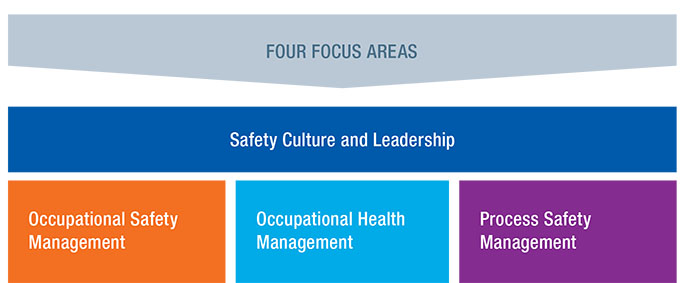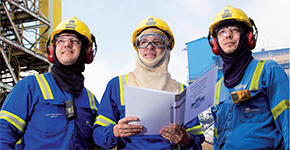世界钢铁协会2019年“安全与职业健康卓越成就奖”表彰活动

世界钢铁协会一直致力于推动全行业在安全与职业健康管理工作中执行最高标准,近期协会举办了“安全与职业健康卓越成就奖”表彰活动,表彰在提升企业职工的安全与职业健康绩效上取得卓越成绩的会员企业,今年有6家会员企业获此殊荣。
世界钢铁协会安全、职业健康及环境部部长Andrew Purvis在谈及此次表彰活动时表示:“随着钢铁行业的发展,我们面临的安全隐患也在发生变化,世界钢铁协会的会员公司积极开发新的工具和技术,他们以零伤害为目标,积极管控新出现的和已有的安全风险。我祝贺这些获奖企业并希望他们的成功经验能被其他同行企业借鉴。”
参选项目的主要评选标准延续以往的标准,尽管具体标准因奖项不同有所差异,但最主要的评选标准还是是否履行世界钢铁协会的六大安全与职业健康管理守则,履行该守则是否对安全绩效及安全成熟度有所提升、及是否易于被世界钢铁协会其他会员企业借鉴。
获奖公司及其项目介绍如下:
安全文化与领导力
卡塔尔钢铁公司:直观的、以身作则的领导力
所谓“直观的、以身作则的领导力”,是指领导层积极参与工厂的职业健康、安全和环境管理工作。在卡塔尔钢铁公司,职业健康、安全和环境工作不仅是一个工作重点,而且还是团队最重要的价值观。在考察和采纳任何决策之前,都要首先进行风险评估,判断该决策可能给人员和工厂的职业健康与安全以及周围环境造成的影响。2018 年6 月卡塔尔钢铁公司开始实施安全观察计划,之后每周都要监控安全观察系统的实施情况。不到一年时间,该公司就取得了大幅改进,合规水平超过98%。卡塔尔钢铁公司认识到,安全不仅体现在安全事故的数量减少上,该公司还引进大量控制措施,并且保持相当高的投入水平。直观的、以身作则的领导力不是在会议室内“坐而论道”,而要亲自走访工厂并执行。
职业安全管理
巴西盖尔道集团:预防死亡事故与严重工伤
2016 年11 月至2017 年10 月,是盖尔道集团的艰难时期,该公司发生数起重大安全事故。该公司认为,这些安全事故不可接受,于是开展安全实践的审查和分析工作,寻找可能的安全短板。于是,该公司组建了专门的工作组,重新审视公司的安全管理实践,研究“潜在重大伤亡和死亡事故”管理理念。主要研究成果表明,重大伤亡(SIF)和死亡事故与非重大伤亡的成因和关联关系不同。按照潜在重大伤亡的概念,不同程度工伤拥有不同的底层原因;相对于轻度工伤,要减少重大工伤,需要采取不同的策略。重大工伤的减少需要考虑来自所有可用数据源的所有前导事件数据:意外事故、工伤、未遂事故和风险暴露等。在实施“潜在重大伤亡事件”管理理念之后,该公司在超过18 个月期间(超过1.5 亿个工作人时)均未发生任何人员死亡事故,这在公司创下纪录,并且对于一家拥有超过4.3 万名雇员与协议工的公司而言,这也是一项卓越的成就。
澳大利亚利百得钢铁公司:手部安全先导工作组
手掌、手腕和手指的受伤仍然是我们行业最常见的工伤。过去3 年间,利百得钢铁公司金属中心业务部发生85 起工伤和未遂事故,涉及手腕、手指和手掌,伤害程度既有轻度割伤和擦伤,也有需要医学干预的严重撕裂伤和骨折。为了认识我们业务部门造成手部伤害的主要原因,以及确认减少手部伤害发生的策略,2017 年6 月我们组建了手部安全先导工作组。这些工具箱由手部安全先导工作组历时18 个月完成,与参与者具有一定互动性和关联性。工具箱中设计的活动包括掌纹画(一种可以辨识雇员每天接触产品次数的软件)和手部安全观察工具。在手部安全先导工作组实施该互动计划之前,虽然公司定期讨论手部安全问题,但信息传达的效果似乎并不理想。手部安全团队在减少手部工伤事故上发挥了重要作用。
印度京德勒钢铁与电力公司:安全指数– 强化安全绩效的催化剂
最近,京德勒钢铁与电力公司推出安全指数的概念,通过公司各个层面的参与,强化企业安全绩效。各部门的主动参数评估由独立的跨部门审查团队进行,该团队由高级领导成员和部门经理组成,使用的是预先定义的核对表和评分系统。主动参数包括安全委员会能否有效发挥职能、潜在事件观测结果的上报情况、标准操作规程的遵守情况、安全培训、法规遵守、工作许可证制度、意外事故报告等。安全指数计划的实施显著提高集团公司的整体安全绩效。例如,过去8 个月间,集团公司未发生重大安全事故,主动参数不断提高,各个层面对安全事务的参与度不断提高,实现全时高产量和高派发量,在国内和国际论坛上获得表彰,员工士气得到提升,工人与主管之间的关系得到改善等。另外,由于安全指数与企业生产激励计划之间的联动,安全方面的竞争环境得到进一步完善。
职业健康管理
巴西米纳斯吉拉斯黑色冶金公司:综合健康系统
米纳斯吉拉斯综合健康系统(SISU)设立于2016年,此前该公司深度分析了本公司的传统健康体系。综合健康系统是一个健康管理模型,包括四个不同领域:职业健康、健康宣传和疾病预防、医学和齿科健保以及社会福利。为确保综合健康系统达到预期效果,该公司组建了一个跨学科健康小组。健康小组旨在协调战略性健康规划,以及这四个领域整合到其他公司运营部门,例如,人力资源、法务、社会沟通以及整体安全。健康流程的解决方案以科研成果、战略性规划、指标分析成果,因此关系到生产效率、雇员满意度、成本削减等间接利益。目前,健康计划已系统地到部署操作领域,因为不仅公司需要它,雇员和主管也需要它。
工艺安全管理
印度塔塔钢铁有限公司:工艺安全重点设备的管理
“工艺安全管理卓越计划”是塔塔钢铁有限公司为整体实现零工伤目标,而制定的六大安全策略之一。工艺安全管理的框架设计旨在公司所有层面探讨以下三个问题:我们知道哪里会出问题吗?我们知道哪里有安全屏障,确保不会发生问题吗?我们知道安全屏障能否有效,能否能够正常运行吗?对于第一个问题,塔塔公司使用了多个不同的安全隐患辨识工具和风险评估工具来解答。对于其余两个问题,则通过辨识和管理安全屏障来解答,其中可能涉及一些重要任务或配套工艺安全重点设备。在文化上,工艺安全管理改变了雇员对风险评估的认识,从而减少了安全事件,降低了产量损失,提高了设备的利用率。
请登录官网worldsteel.org下载《2019年安全与职业健康卓越成就奖获奖项目介绍》及了解世界钢铁协会更多安全领域的活动。世界钢铁协会于蒙特雷举办的年会上举办了颁奖仪式,为获奖公司颁发了证书,浏览颁奖仪式上的照片,请登录Flickr。
#结束#
编者按:
- 世界钢铁协会是世界上规模最大、活跃度最高的行业协会之一,会员遍布世界各主要产钢国。世界钢铁协会会员覆盖钢铁生产企业、国家和地区钢铁行业协会及钢铁研究机构,会员粗钢产量占全球粗钢总产量的85%左右。


